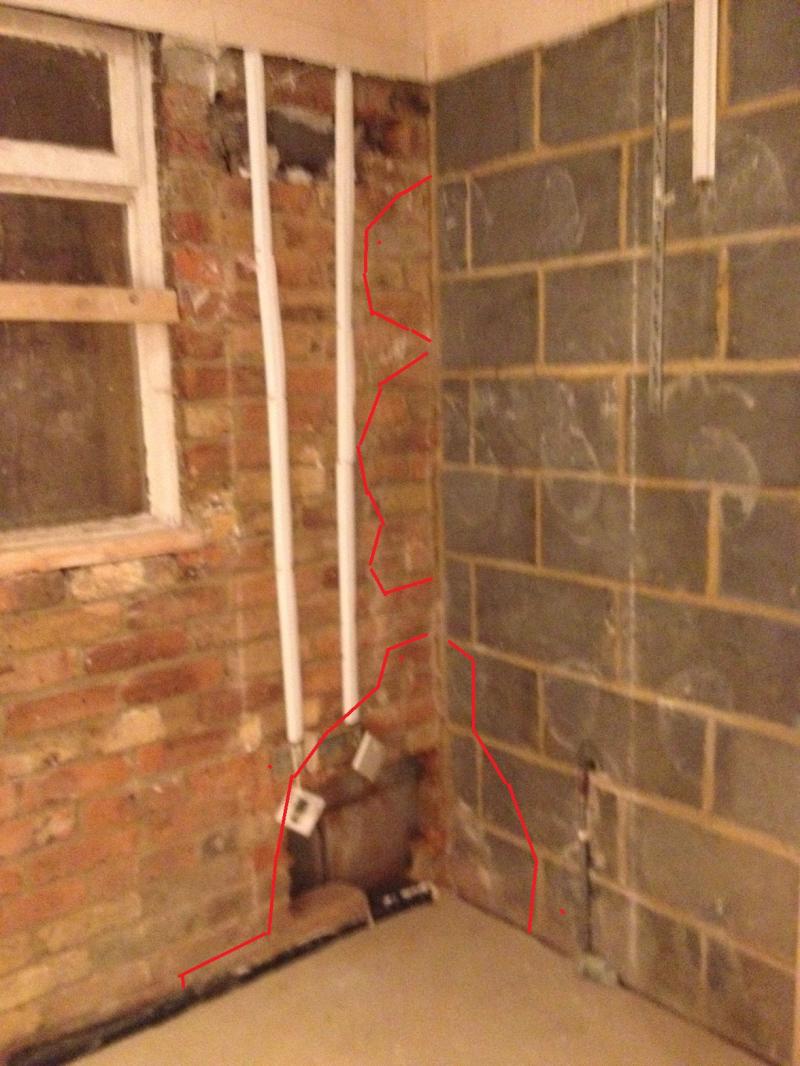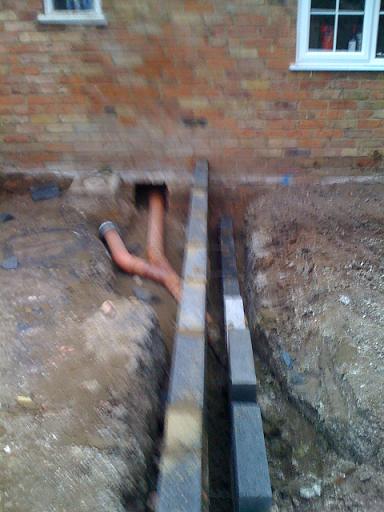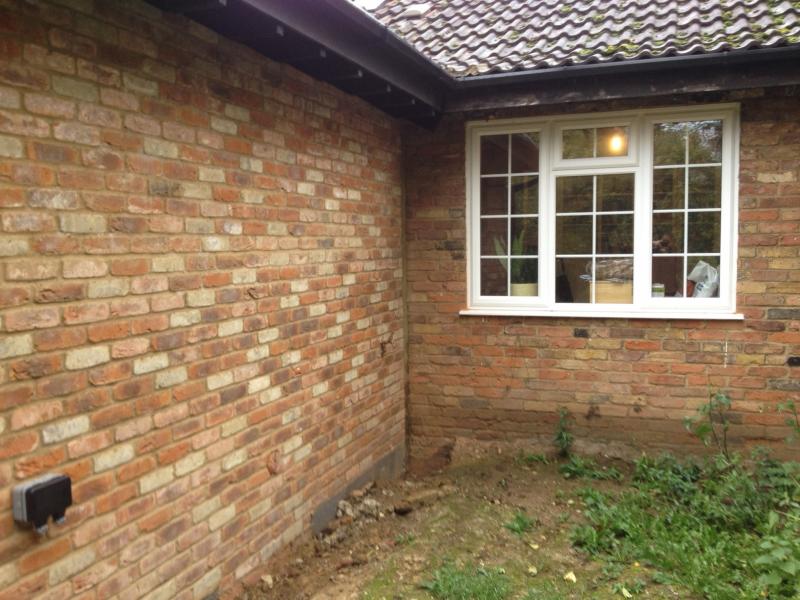Hi,
I had a rear extension built a few months back. Around one corner where the extension joint onto the existing building, there is some damp which we couldn't figure out where it's coming from. We had 4 building inspectors and a surveyor examed the issue and advised varies remedies but none works so far. It's becoming such a headache that no one know where to take it forward. So I thought I'd give the forum a go and any advise would be appreciated.
Below is a photos shows the damp corner internally. Brick wall is the existing house and block wall is the extension. Damp patches (marked red in the picture) have been observed in the corner, mainly on the existing wall but spreading onto the block wall.
There is a bathroom behind the brickwall and soil pipes underneath the floor - see the picture below. But we have hardly used the toilet and the damp issue started before the service was even live so I'm hoping that it's not caused bu escaping water, fingers crossed!!
The next picture taken externally, where damp patches can be seen on the joint motar. What happened was that there wasn't any vertical DPC installed in this corner, which is fairly shelftered. After first inspection of the damp issue, the builder cut into the bricks in the corner from outside and inserted some mastic sealant as vertical DPC, which is why the joint motar looks a bit strange. This didn't work. A question here - is this 'DPC' affective? I would thought that it needs to cover the whole surface in order to work? Building inspector's view is that it's not strictly affective but he doesn't think the lack of vertical DPC here would cause so much damp here, given that the outside is not extremely wet.
We then had another inspector cam around and advised the damp may the normal level of dampt in new building (it was water tight back in July) and advised we use a dehumidifier for a week. When the machine was there it worked great. A week later all damp disappeared. However, good news didn't last long. The second day after the machine was removed, the damp came back gradually, starting from a brick right in the corner 1.2m above the DPC then spreading onto 1.4m. This patch then start to spread further inside and a few days later the low level corner also start to get damp.
Because the way it spreads, I thought it's more like water travelled from the outside wall rather than rising damp or leaking from the top - in fact the top level bricks are fairly dry.
(there is a tap shown on the picture but again it's tested and not leaking.)
Another clue is that the floor of this corner was left to build in the very end, i.e. rest of the floor (hard core, insulation, concrete, screeD) were put in back in April, this corner (1mx2m) was left until June when the drainage pipe work completed. Because of the wet summer we had, this part was extremely wet before the building was water tight in June) but All ground DPC were in place, in fact I know he put in two layers - one below insulation and one above. Would this be an issue?
In addition, there are form insulations in the existing cavity wall, which I heard could cause damp issue. When the wall was opened I removed the insulation where I could reach and they felt damp. However, the bricks where insulation has been removed don't seem to get any dryer.
Final piece of information is that inspector also checked the loft where the two roof joins and didn't observe any leaking. But I wonder whether there is any chance of the gully near the corner leaks and water are trapped in between walls? But if this is the case, shouldn't the damp be on teh top part of the wall rather than middle and bottom part?
At the moment, both us, the builder and the inspector are frustrated and couldn't figure out where the damp could be coming from. The inspector even suggested me to get an independant surveyor to check it but I'm not sure how far I would go on this route.
Any suggestions/thoughts here would be really really appreciated.
Thanks a million in advance!
Heather
I had a rear extension built a few months back. Around one corner where the extension joint onto the existing building, there is some damp which we couldn't figure out where it's coming from. We had 4 building inspectors and a surveyor examed the issue and advised varies remedies but none works so far. It's becoming such a headache that no one know where to take it forward. So I thought I'd give the forum a go and any advise would be appreciated.
Below is a photos shows the damp corner internally. Brick wall is the existing house and block wall is the extension. Damp patches (marked red in the picture) have been observed in the corner, mainly on the existing wall but spreading onto the block wall.
There is a bathroom behind the brickwall and soil pipes underneath the floor - see the picture below. But we have hardly used the toilet and the damp issue started before the service was even live so I'm hoping that it's not caused bu escaping water, fingers crossed!!
The next picture taken externally, where damp patches can be seen on the joint motar. What happened was that there wasn't any vertical DPC installed in this corner, which is fairly shelftered. After first inspection of the damp issue, the builder cut into the bricks in the corner from outside and inserted some mastic sealant as vertical DPC, which is why the joint motar looks a bit strange. This didn't work. A question here - is this 'DPC' affective? I would thought that it needs to cover the whole surface in order to work? Building inspector's view is that it's not strictly affective but he doesn't think the lack of vertical DPC here would cause so much damp here, given that the outside is not extremely wet.
We then had another inspector cam around and advised the damp may the normal level of dampt in new building (it was water tight back in July) and advised we use a dehumidifier for a week. When the machine was there it worked great. A week later all damp disappeared. However, good news didn't last long. The second day after the machine was removed, the damp came back gradually, starting from a brick right in the corner 1.2m above the DPC then spreading onto 1.4m. This patch then start to spread further inside and a few days later the low level corner also start to get damp.
Because the way it spreads, I thought it's more like water travelled from the outside wall rather than rising damp or leaking from the top - in fact the top level bricks are fairly dry.
(there is a tap shown on the picture but again it's tested and not leaking.)
Another clue is that the floor of this corner was left to build in the very end, i.e. rest of the floor (hard core, insulation, concrete, screeD) were put in back in April, this corner (1mx2m) was left until June when the drainage pipe work completed. Because of the wet summer we had, this part was extremely wet before the building was water tight in June) but All ground DPC were in place, in fact I know he put in two layers - one below insulation and one above. Would this be an issue?
In addition, there are form insulations in the existing cavity wall, which I heard could cause damp issue. When the wall was opened I removed the insulation where I could reach and they felt damp. However, the bricks where insulation has been removed don't seem to get any dryer.
Final piece of information is that inspector also checked the loft where the two roof joins and didn't observe any leaking. But I wonder whether there is any chance of the gully near the corner leaks and water are trapped in between walls? But if this is the case, shouldn't the damp be on teh top part of the wall rather than middle and bottom part?
At the moment, both us, the builder and the inspector are frustrated and couldn't figure out where the damp could be coming from. The inspector even suggested me to get an independant surveyor to check it but I'm not sure how far I would go on this route.
Any suggestions/thoughts here would be really really appreciated.
Thanks a million in advance!
Heather




